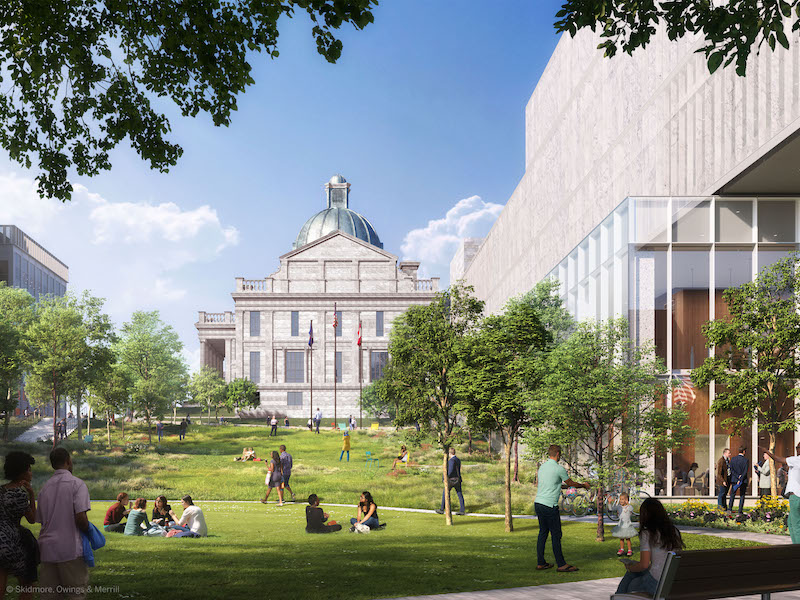Ground broke today on the largest project that Montgomery County in Pennsylvania has undertaken to date: a 508,150-sf campus in the Philadelphia suburb of Norristown, Pa., that, when completed in 2026, will include the construction of the 330,000-sf, six-story Montgomery County Justice Center.
Skidmore, Owings & Merrill (SOM) and Skanska are the design and construction partners on this $415 million project, which was approved last September by the Norristown Municipal Council. According to local reports, the existing courthouse was originally to be renovated at a budget of $281 million. And the more expensive construction contract had met with some political opposition.
Also see: A new county courthouse opens in Olathe, Kan.
But other municipal leaders see this bolder project as being transformative for the city and the community. “The Justice Center represents years of planning to design a state-of-the-art facility that will meet the County’s needs for the next century and make all justice-related services more accessible to our residents,” stated Dr. Valerie A. Arkoosh, Chair of the Montgomery County Board of Commissioners.
Also see: Designs for federal courthouse in Alabama unveiled
CAN A COURTHOUSE REVIVE A TOWN?

SOM has designed the new Justice Center with new public spaces and access to the city's main thoroughfares.
The project has three components:
•The new Justice Center construction, which is targeting LEED Gold certification. That building, which will be attached to the existing courthouse, will have 18 courtrooms, offices, and public spaces. Its cladding is primarily fritted glass with a marble pattern, a nod to the building’s historic neighbor and a contemporary take on the Pennsylvania “King of Prussia” Blue Marble quarried in Montgomery County.
•The expansion of Hancock Square Park to 57,000 sf, from its current size of 23,000 sf. (The project’s landscape architect is GGN.) That expansion will feature native landscape plantings, and direct access to Norristown’s Main Street.
•The historic courthouse, which was built in 1856 and expanded in 1902 (its dome), 1930 (its annex), and 1970, will undergo a complete renovation, with attention paid to historic preservation and a full replacement of utility infrastructure. A new glazed atrium links the existing and new buildings, creating a bright and welcoming entrance to the complex while emphasizing both the rich past and promising future of Montgomery County.
NEW PUBLIC SPACES

This project will more than double the size of Hancock Square Park.
Collectively, the project’s sustainability features will realize a 26% energy use reduction over ASHRAE 90.1 2013, a 40% indoor water use reduction, and a 50% irrigation reduction, according to SOM. (Interface Engineering is this project’s engineer.)
Skanska Integrated Solutions, a wholly owned subsidiary of the giant general contractor, is the project’s Agency Construction Manager, and is overseeing its planning, design, and construction. SOM’s design of the Justice Center will create new public spaces and connections within the complex and the surrounding streets.
The Justice Center will “restore a county landmark, and introduce a bold new building that speaks to the county's bright future,” says SOM’s Design Partner Colin Koop. Both he and Skanska Vice President and Regional Director Christopher Anderson see this project as part of a downtown revitalization.
Related Stories
| Aug 11, 2010
Financial Wizardry Builds a Community
At 69 square miles, Vineland is New Jersey's largest city, at least in geographic area, and it has a rich history. It was established in 1861 as a planned community (well before there were such things) by the utopian Charles Landis. It was in Vineland that Dr. Thomas Welch found a way to preserve grape juice without fermenting it, creating a wine substitute for church use (the town was dry).
| Aug 11, 2010
Special Recognition: Triple Bridge Gateway, Port Authority Bus Terminal New York, N.Y.
Judges saw the Triple Bridge Gateway in Midtown Manhattan as more art installation than building project, but they were impressed at how the illuminated ramps and bridges—14 years in the making—turned an ugly intersection into something beautiful. The three bridges span 9th Avenue at the juncture where vehicles emerge from the Lincoln Tunnel heading to the Port Authority of New Yor...
| Aug 11, 2010
Jefferson Would Be Proud
The Virginia State Capitol Building—originally designed by Thomas Jefferson and almost as old as the nation itself—has proudly served as the oldest continuously used Capitol in the U.S. But more than two centuries of wear and tear put the historical landmark at the head of the line for restoration.
| Aug 11, 2010
29 Great Solutions
1. Riverwalk Transforms Chicago's Second Waterfront Chicago has long enjoyed a beautiful waterfront along Lake Michigan, but the Windy City's second waterfront along the Chicago River was often ignored and mostly neglected. Thanks to a $22 million rehab by local architect Carol Ross Barney and her associate John Fried, a 1.
| Aug 11, 2010
Platinum Award: The Handmade Building
When Milwaukee's City Hall was completed in 1896, it was, at 394 feet in height, the third-tallest structure in the United States. Designed by Henry C. Koch, it was a statement of civic pride and a monument to Milwaukee's German heritage. It was placed on the National Register of Historic Places in 1973 and designated a National Historic Landmark in 2005.
| Aug 11, 2010
John Adams Courthouse
After more than a century without a substantial renovation, Old Suffolk County Courthouse, designed in Neo-Classical style by Boston's first city architect, George Clough, was overdue for a facelift. Enter the makeover team: Boston-based architects Childs, Bertman, Tseckares and general contractors Suffolk Construction/NER Construction Management.
| Aug 11, 2010
The pride of Pasadena
As a shining symbol of civic pride in Los Angeles County, Pasadena City Hall stood as the stately centerpiece of Pasadena's Civic Center since 1927. To the casual observer, the rectangular edifice, designed by San Francisco Classicists John Bakewell, Jr., and Arthur Brown, Jr., appeared to be aging gracefully.







